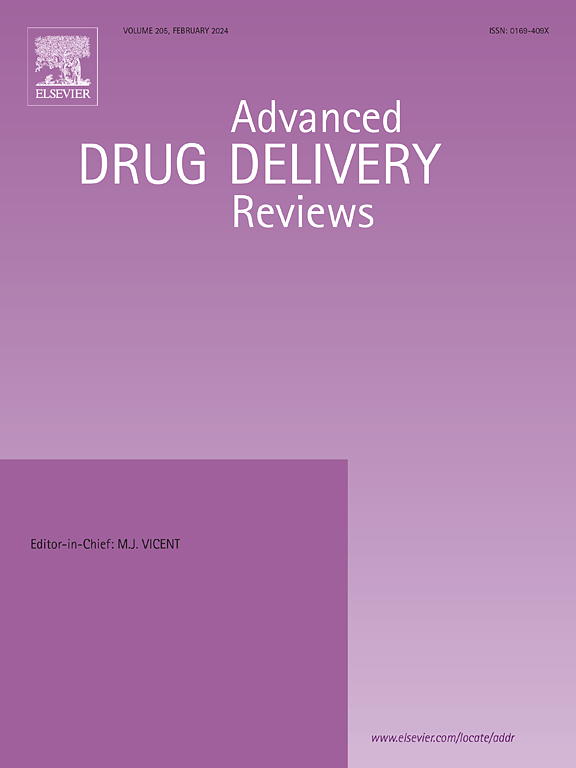Devices to overcome the buccal mucosal barrier to administer therapeutic peptides
IF 17.6
1区 医学
Q1 PHARMACOLOGY & PHARMACY
引用次数: 0
Abstract
Peptide therapeutics are important in healthcare owing to their high target specificity, therapeutic efficacy, and relatively low side effect profile. Injections of these agents have improved the treatment of chronic diseases including autoimmune, metabolic disorders, and cancer. However, their administration via injections can prove a barrier to patient acceptability of treatments. While oral delivery of these molecules is preferable, oral peptide formulations are associated with limited bioavailability due to degradation in the intestine and low epithelial permeability. Buccal administration of peptides is a potential alternative to injections and oral formulations. Similar to the oral route, the buccal route can promote better patient adherence to dosing regimens, along with the added advantages of not requiring restriction on food or drink consumption before and after administration, as well as avoidance of the liver first-pass metabolism. However, like oral, effective buccal absorption of peptides is still challenging due to the high epithelial permeability barrier. We present a multidisciplinary approach to understanding the buccal physiological barrier to macromolecule permeation and discuss how engineered devices may overcome it. Selected examples of buccal devices can facilitate fast and efficient macromolecule absorption through multiple mechanisms including physical disruption of epithelia, convection-based mass transfer, and a combination of physicochemical strategies. Importantly, minimally invasive devices can be self-applied and are associated with the maintenance of the barrier after exposure. We analysed the critical attributes that are required for the clinical translation of buccal peptide administration devices. These include performance-driven device development, manufacturing features, patient acceptability, and commercial viability.


克服口腔黏膜屏障的装置来给药治疗肽
肽疗法在医疗保健中很重要,因为它们具有高靶向特异性、治疗效果和相对较低的副作用。这些药物的注射改善了慢性疾病的治疗,包括自身免疫性疾病、代谢紊乱和癌症。然而,通过注射给药可以证明是患者接受治疗的障碍。虽然口服递送这些分子是优选的,但口服肽制剂由于在肠内降解和低上皮通透性而具有有限的生物利用度。口腔给药多肽是一种潜在的替代注射和口服制剂。与口服途径类似,口腔途径可以促进患者更好地遵守给药方案,同时在给药前后不需要限制食物或饮料的摄入,以及避免肝脏首过代谢的额外优点。然而,与口服一样,由于高上皮通透性屏障,口腔对肽的有效吸收仍然具有挑战性。我们提出了一种多学科的方法来理解口腔对大分子渗透的生理屏障,并讨论了工程装置如何克服它。口腔装置可以通过多种机制促进快速有效的大分子吸收,包括对上皮的物理破坏,对流传质以及物理化学策略的结合。重要的是,微创装置可以自我应用,并与暴露后的屏障维护有关。我们分析了口腔肽给药装置临床翻译所需的关键属性。这些因素包括性能驱动的设备开发、制造特性、患者可接受性和商业可行性。
本文章由计算机程序翻译,如有差异,请以英文原文为准。
求助全文
约1分钟内获得全文
求助全文
来源期刊
CiteScore
28.10
自引率
5.00%
发文量
294
审稿时长
15.1 weeks
期刊介绍:
The aim of the Journal is to provide a forum for the critical analysis of advanced drug and gene delivery systems and their applications in human and veterinary medicine. The Journal has a broad scope, covering the key issues for effective drug and gene delivery, from administration to site-specific delivery.
In general, the Journal publishes review articles in a Theme Issue format. Each Theme Issue provides a comprehensive and critical examination of current and emerging research on the design and development of advanced drug and gene delivery systems and their application to experimental and clinical therapeutics. The goal is to illustrate the pivotal role of a multidisciplinary approach to modern drug delivery, encompassing the application of sound biological and physicochemical principles to the engineering of drug delivery systems to meet the therapeutic need at hand. Importantly the Editorial Team of ADDR asks that the authors effectively window the extensive volume of literature, pick the important contributions and explain their importance, produce a forward looking identification of the challenges facing the field and produce a Conclusions section with expert recommendations to address the issues.

 求助内容:
求助内容: 应助结果提醒方式:
应助结果提醒方式:


